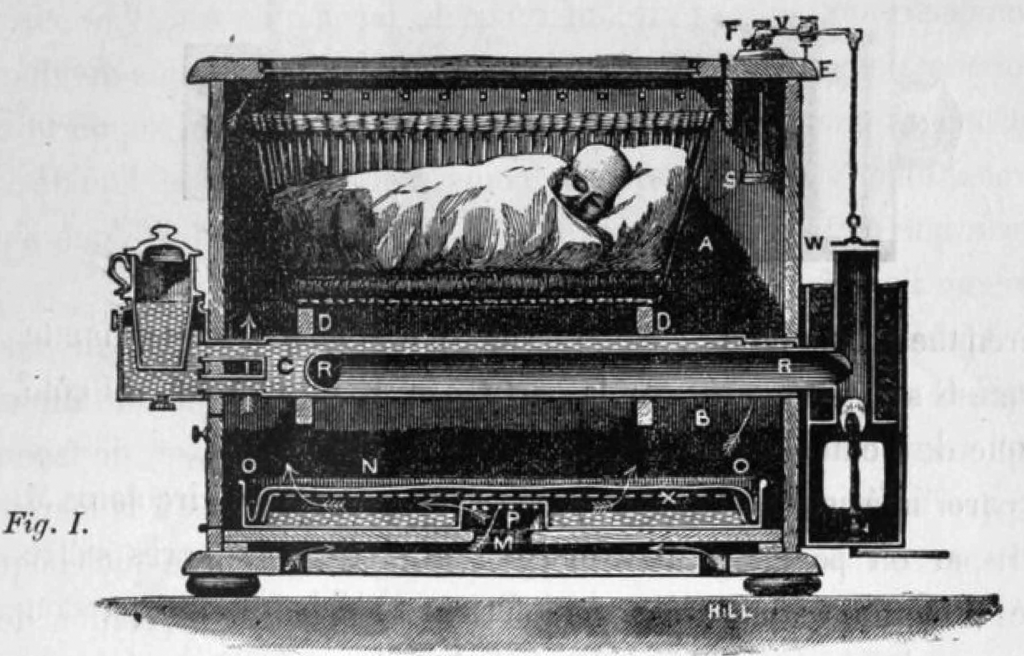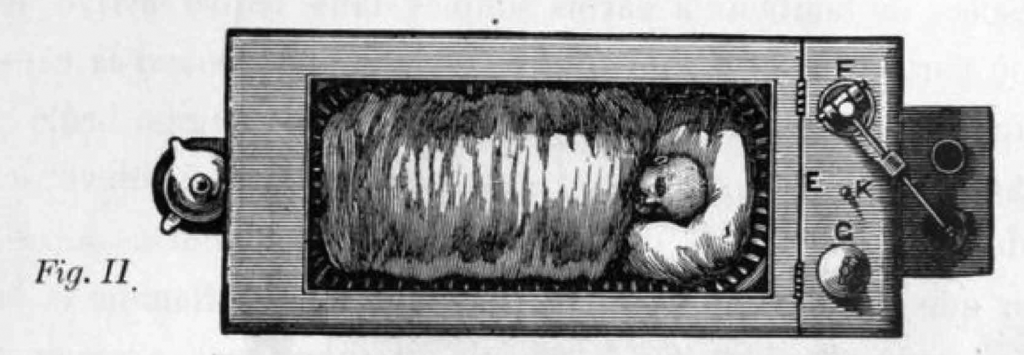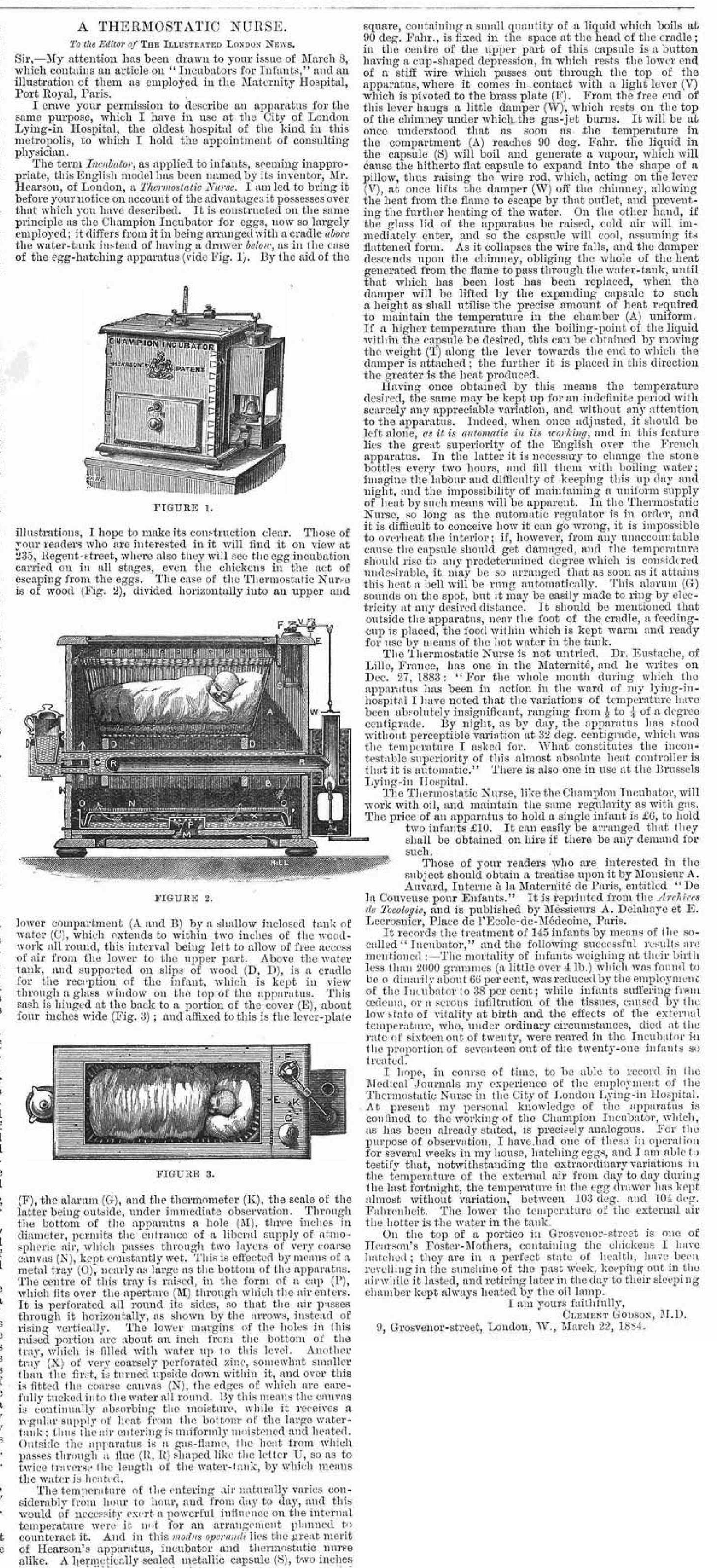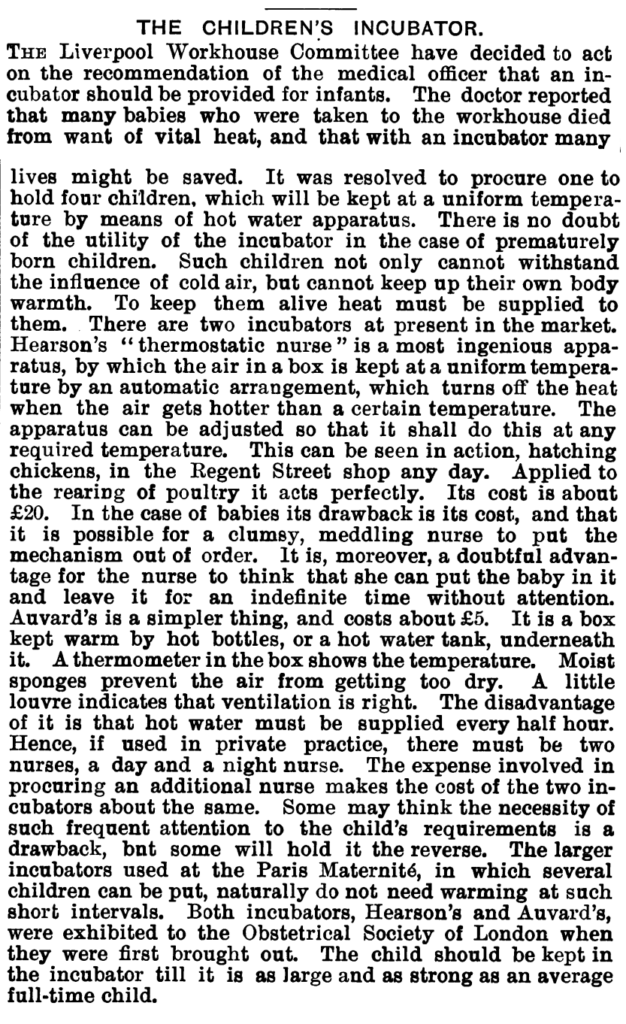Hearson’s Thermostatic Nurse
The Hearson Thermostatic Nurse was manufactured by Charles Hearson & Co., Ltd., London, a manufacturer of poultry and biological incubators and other apparatus. A shallow tank of water in the lower compartment was heated by oil or gas. The incubator cost £6 for one infant and £10 for a larger version that could accommodate two infants.
The genesis of the Hearson incubator is described by G. Eustache in his article Une Nouvelle Couveuse pour Enfants Nouveau-Nés, first published as an offprint in 1884, later published in Journal des Sciences Médicales de Lille in 1885. Eustache was well aware of Tarnier’s work at the Maternité, and refers to Tarnier’s incubator multiple times in his article.
At the time of the Palais Rameau Exhibition, several varieties of egg incubators were exhibited. My attention was especially attracted by the Champion poultry incubator which promised constant regularity and automatic temperature thanks to its thermostatic capsule. You all know this incubator which is already very widespread.
The transformation of this incubator for eggs into an incubator for children was easy by following very nearly the same principles that had guided Mr. Tarnier in the transformation of the Odile Martin [poultry] incubator. Together with the Lille representative of Hearson, London, which operates the Champion incubator patent in France, we drew up a project based on the following points:
The lower compartment of the Champion incubator, the actual incubator, is removed. The upper compartment, or dryer for the little chicks which have just hatched, would be enlarged so as to be able to contain two wicker baskets which would serve as cradles.
The Champion appliance provides ample access and renewal of clean air, which enters through an opening in the bottom and escapes through a series of holes placed near the lid. But to fulfill the new role for which it is intended, the air must be sufficiently humidified. In order to achieve this result, we agreed on the following provision:
A metal tub (0.0) is placed on the bottom of the incubator. The middle of this bucket is raised at P and forms a cover over the opening M through which the air passes. This lid is pierced with numerous holes around its entire circumference so that the air circulates horizontally in the direction of the arrows. A largely perforated zinc plate X covers the tub full of water and supports a large canvas N whose four corners are immersed in the liquid, so that this tissue is constantly soaked with humidity, impregnating the air to enter it. in incubator (Fig. 1).

After having ensured the continuous renewal of a pure and humid air, we then had to take care of automatically maintaining a uniform temperature in the incubator, so that the constancy of this temperature was not at the mercy of more or less vigilance and assiduity of any guard.
For this, we had to change nothing in the layout of the Champion incubator, since it guarantees this automatic consistency.
We only asked the builder to give us thermostatic capsules operating at 33 degrees Centigrade. Mr. Tarnier, during his first tests had used 36 degrees, later he only used 30 degrees. I opted for the happy medium. In any case, this question of the most suitable temperature is not yet resolved; it will only be so later by prolonged experience.
All things being thus provided for, the construction of the apparatus became simple and easy; it was performed quickly and skillfully in London by the Hearson firm which, less than two months later, in October 1883, sent me, free of charge I must add, the new incubator which I am now going to describe to you.
It consists of a rectangular wooden box measuring 95 centimeters high, 85 wide and 80 deep and is used for two children.
The interior of this box is divided into two compartments A and B of approximately equal height by wooden crosspieces D.
The lower compartment contains a flat and horizontal hot water tank, arranged in such a way as to leave all around it between the edges and the walls of the box a free space for the circulation of air. This reservoir is about 15 centimeters from the bottom of the body; this interval is occupied by the tub of water which I spoke to you about above O O P N.
The upper wall of the box is formed by a double movable frame, the glass of which allows the interior to be watched. By lifting this frame, we have access to the incubator, and we can thus remove or put back the children at will. The crosspiece which separates these two frames certifies a point of support for the thermostatic device which will be discussed and gives way to a thermometer which provides constant information on the temperature inside the incubator.
When the incubator is built for a single child, as shown in the following figure (Fig.11), the thermostatic device F, the thermometer K and in addition a safety bell G are supported by the fixed part E of the frame, on the side of the child’s head.

The lower wall is pierced at its center with a circular hole M (Fig. 1) through which the atmospheric air enters. This one after being charged with humidity in the lower floor, heats up while passing all around the tank and thus rises in the upper compartment from where it can escape through a series of practical holes on the walls. of the incubator close to the lid.
On the sides of the apparatus is placed a gas lamp or a kerosene lamp. The heat provided by the flame of this lamp passes through a horseshoe-shaped R R tube which runs twice the width of the hot water tank so as to obtain a larger heating surface. This lamp is related to the temperature regulating device or thermostatic device.
This is combined as follows: In the upper compartment of the incubator there is a hermetically sealed capsule of 4 to 5 square centimeters containing in its interior a liquid which comes to a boil at a determined temperature (33 degrees centigrade for the children’s incubator). On this capsule presses a lever, which rises or lowers depending on whether the capsule swells or flattens. The movement of this lever is transmitted outside the apparatus and acts in a different way depending on whether the operation takes place on gas or oil.
The first incubator built, the one I own, runs on gas. The lever which rests on the capsule presses by its other end on a kind of flexible-walled drum into which the gas arrives and from which the lamp supply pipe comes. When the capsule is flattened, the gas passes freely and the lamp burns at full flame. If the capsule is distended and the lever lifts, the passage of gas is diminished; only the quantity necessary so that the lamp does not go out is circulated. From then on the flame and the heat drop until the capsule has resumed its first dimensions. There is an automatic adjustment of the lamp and consequently of the heat developed by it in the hot water tank and in the brooder.
In the new models built by Hearson, the temperature setting is a little different although based on the same principle. These incubators can run on gas, oil or petrol. (Fig. 1).
To the thermostatic capsule is fitted a lever V which works at F. At the end of this lever arm is attached the lid W under which the flame burns.
When the capsule swells, the operculum W rises; the caloric provided by the flame escapes directly into the air without passing through the RR tube through which the hot water tank passes. From then on this water tends to cool, and the temperature inside the incubator drops below the boiling point of the continuous liquid in the capsule. This flattens, the lever lowers; the operculum W is also lowered; and forces the heat to pass through the RR tube located in the water tank, the temperature of which rises. There is a constant play of balance here which keeps the temperature entirely uniform.
On the lever arm V is a slider T which is used to adjust the device when it is started, and which can also later be used to correct the variations which one would have noted.
Let us add, to complete the description of the apparatus, a happy addition imagined by the builder who placed outside the incubator on the side of the feet of the cradle a small vase, the bottom of which bathes in the water of the tank and thus makes it possible to preserve a drink always lukewarm, in case of need.
Such is the description of the new incubator which I have had for a year and which I have submitted to a certain number of tests.
For the English audience, the incubator was described in an article by Clement Godson, MD in the Illustrated London News, April 12, 1884.

The incubator also earned a mention in the 1911 version of the Encyclopedia Brittanica, and the British Medical Journal.
The upper chamber contains the infant, but the lower is not a heating but a moistening chamber. Through apertures (M) in the bottom of the lower chamber, the external air passes through, and as in the chick incubator it then passes through perforations in the inner cylinder of a water tray (0) and thence over the surface of the water in the tray, through a sheet of wet canvas, to the chamber itself. Hence it passes to the infant chamber and ultimately leaves this through a series of perforations round the top. The air in both chambers is heated by a warm-water tank. This tank forms the partition which divides the incubator into upper and lower chambers and is made of metal. Through the water contained in it, an incoming (R) and an outgoing (R) to the left flue, continuous with each other, pass. These two flues are related to each other as in Hearson’s chick incubator, and the inlet flue is heated in the same way and the outlet flue discharges similarly. The heat-regulating apparatus is identical with that in the chick incubator, and the thermostatic capsule (S) is placed in the upper chamber, near the head of the infant. The child is placed in a basket which has perforated walls, and is open above. The basket rests upon two shallow supports (D) situated on the upper surface of the water-tank partition. The child is kept under observation through a glass door in the upper or roof-wall of the incubator. In Great Britain this apparatus is in use at various hospitals and workhouses throughout the country, and provided there is no great fluctuation of barometric pressure, it maintains a uniform temperature. — Encyclopedia Brittanica, 1911

Last Updated on 01/14/24